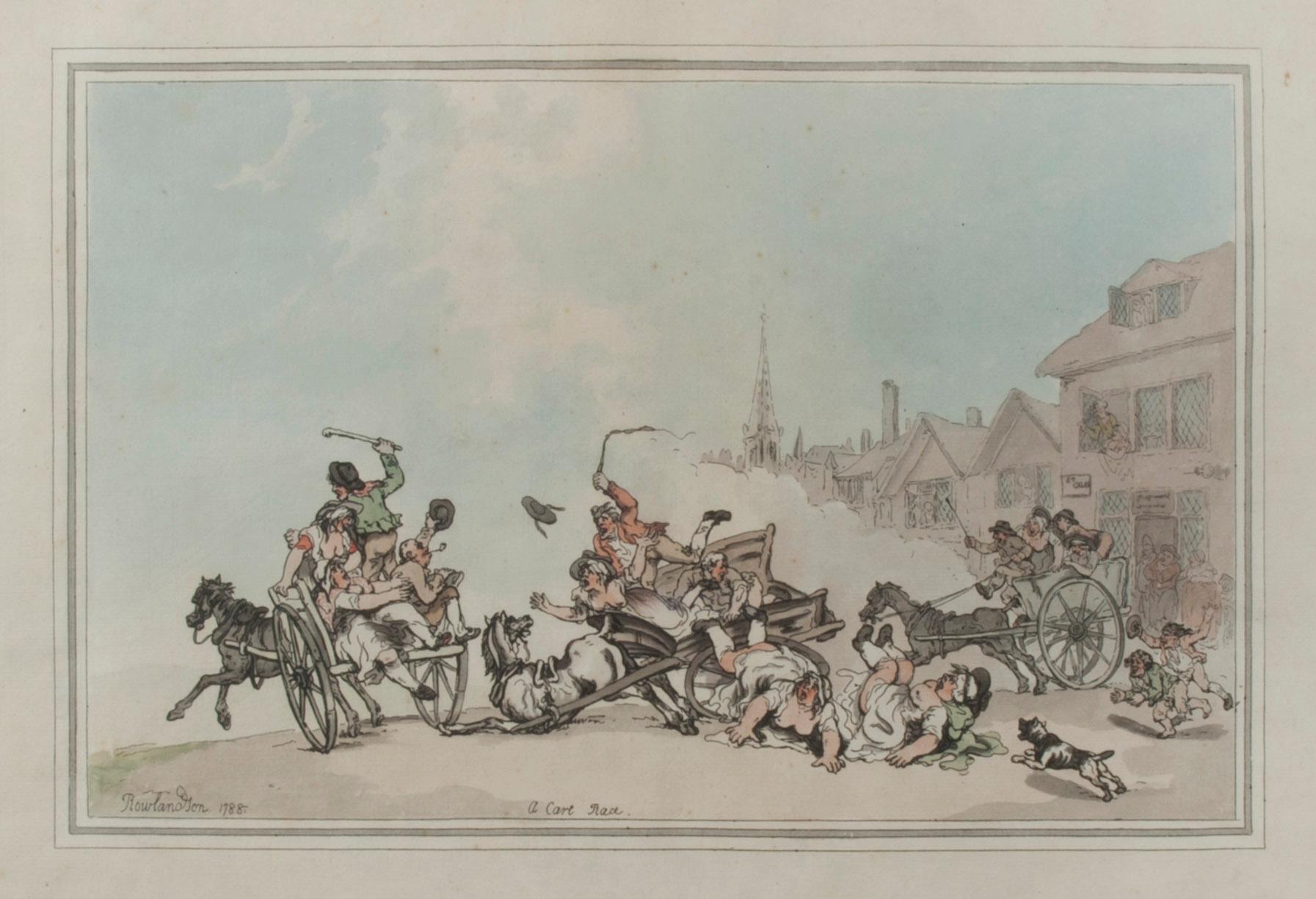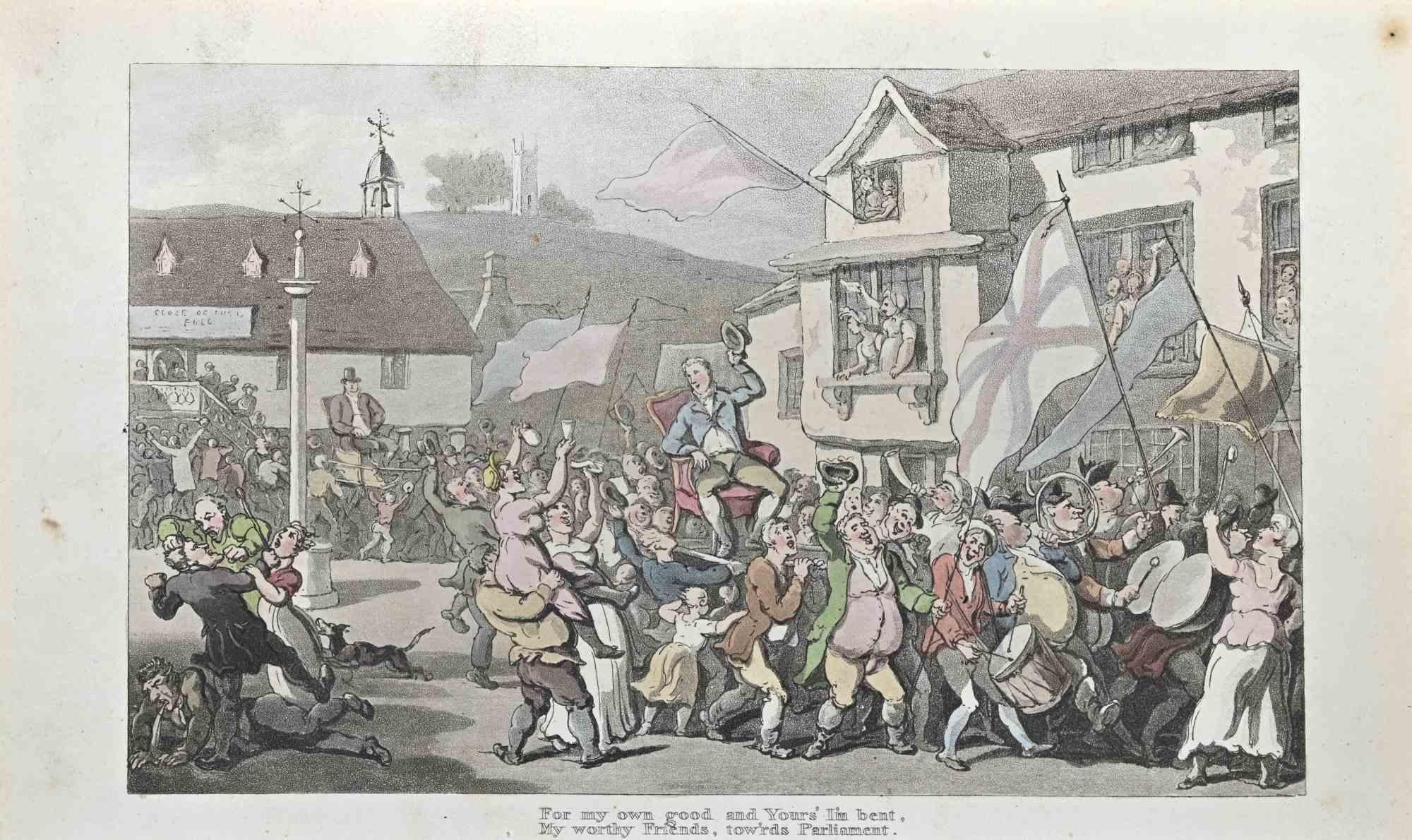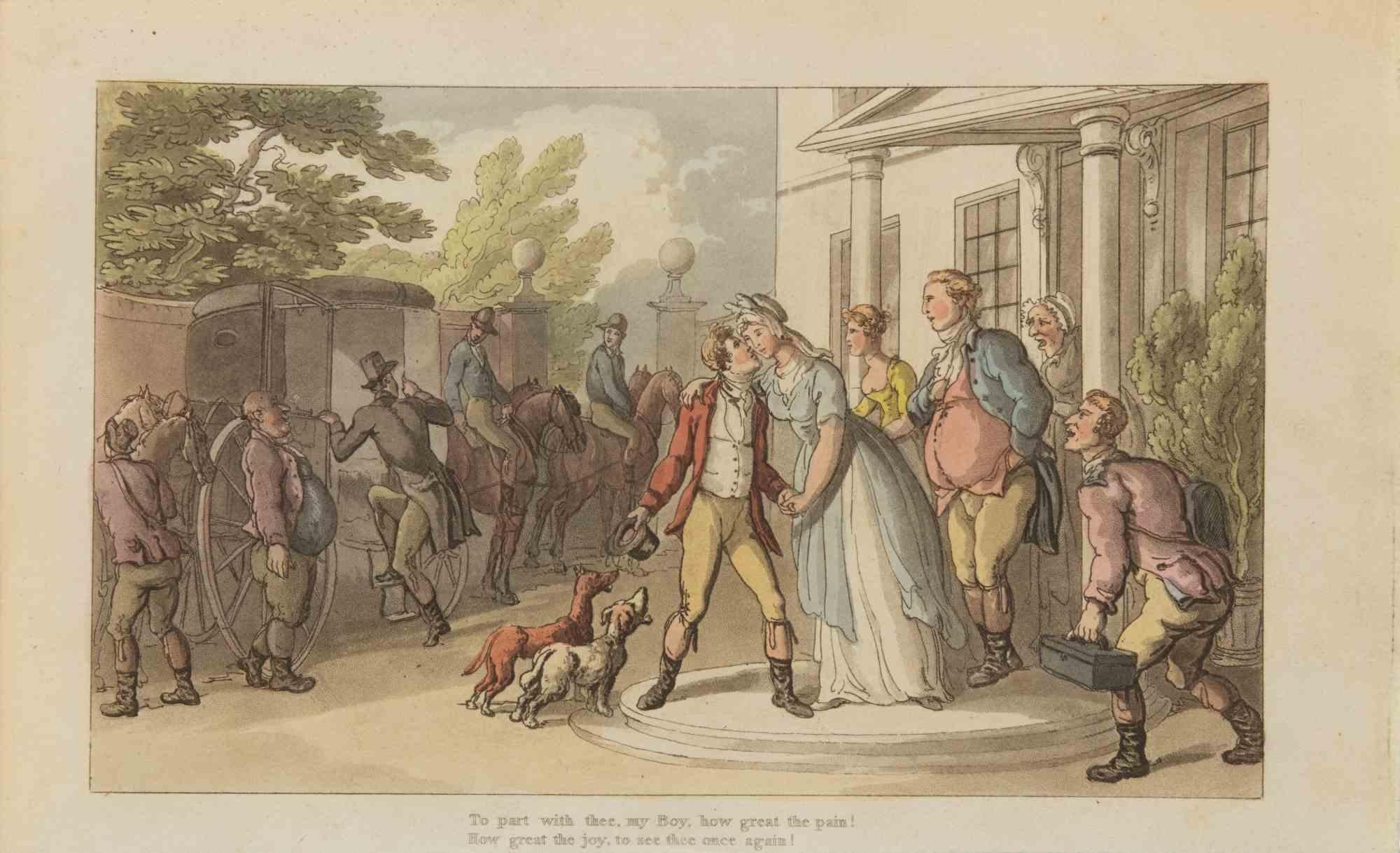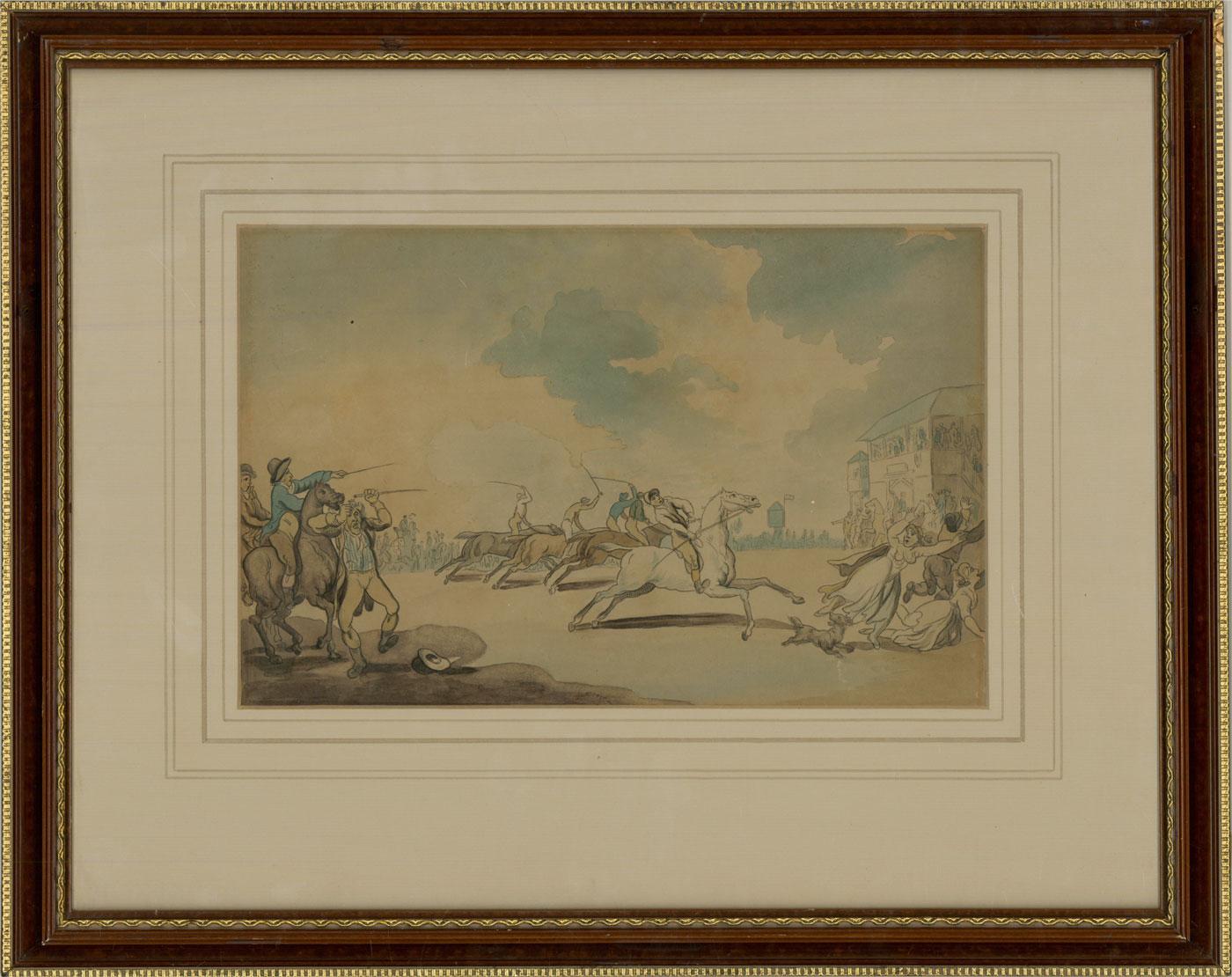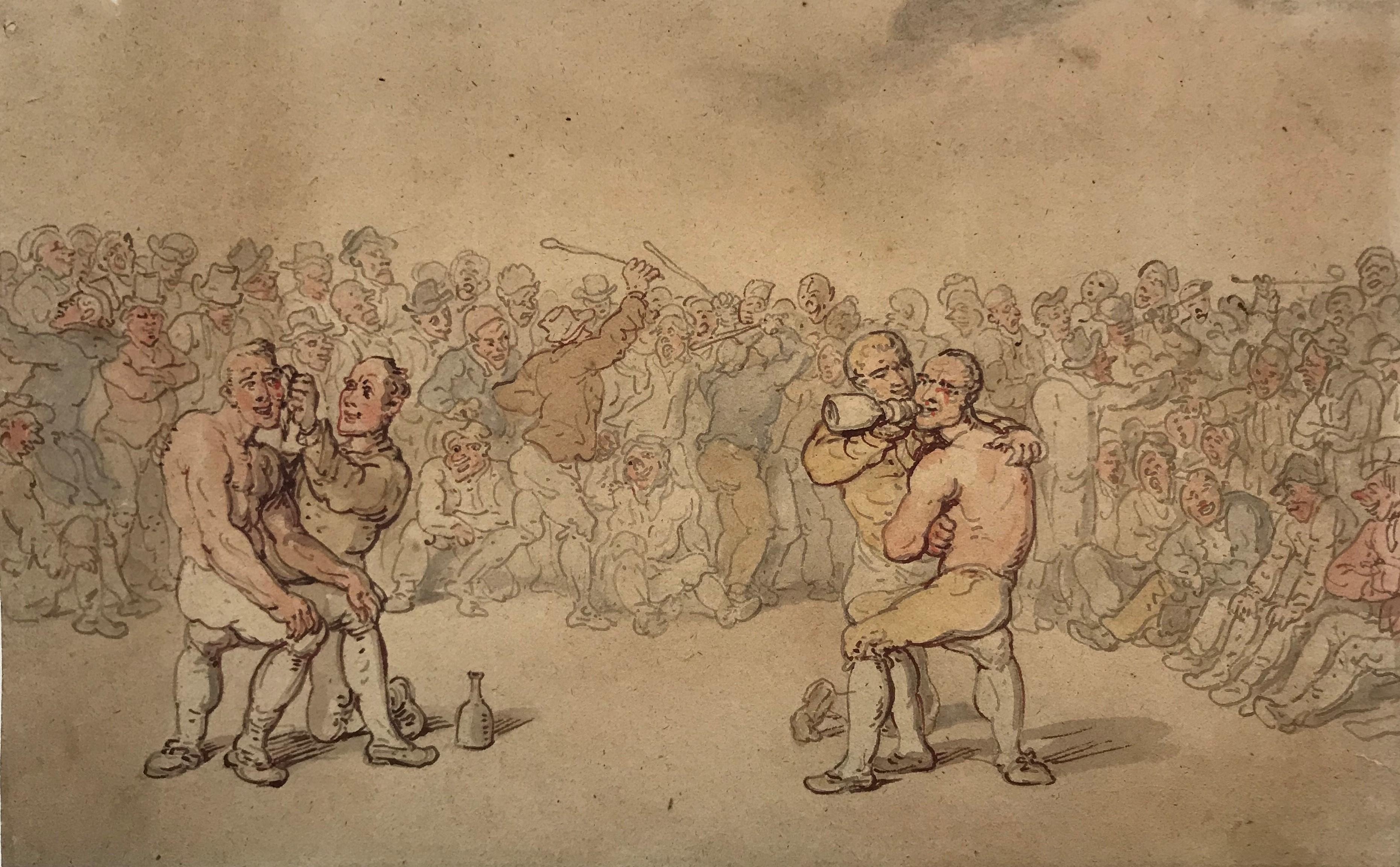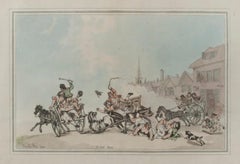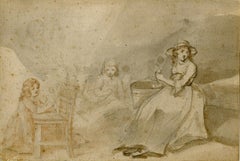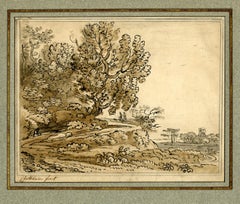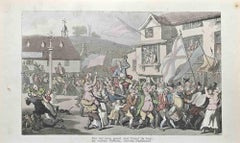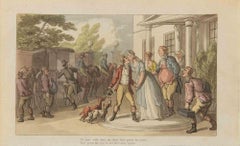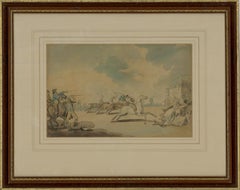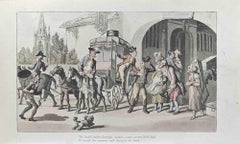Items Similar to Recruits on a March
Want more images or videos?
Request additional images or videos from the seller
1 of 10
Thomas RowlandsonRecruits on a Marchc. 1800
c. 1800
$4,000
£3,020.64
€3,458.35
CA$5,649.05
A$6,167.41
CHF 3,233.32
MX$74,905.52
NOK 40,378.88
SEK 38,128.43
DKK 25,812.94
About the Item
Recruits on a March
Ink and watercolor on paper, mounted on support
Unsigned
Condition: watercolor sheet laid down on paper, moderately faded
Original Ackermann frame and matting
Image size: 7 1/2 x 10 1/2 inches
Frame: 15 x 17"
Provenance: Arthur Ackerman & Sons, Inc., Chicago
Ackerman was the publisher of most of Rowlandson books and original prints. They also sold original works
by Rowlandson, this example being one of them.
Charles E. Pierce, Jr. , Director Emeritus, Morgan Library and Museum, New York
Arthur Ackermann & Sons, Inc, was owned by W. Russell Button, adopted son of Ackermann. The print business which Ackermann had established for his eldest son Rudolph at 191 Regent Street (later in Bond Street) survived as Arthur Ackermann & Son. In the 1930’s it opened branches in America, at 408 South Michigan Avenue Chicago.
- Creator:Thomas Rowlandson (1756 - 1827, British)
- Creation Year:c. 1800
- Dimensions:Height: 7.5 in (19.05 cm)Width: 10.5 in (26.67 cm)
- Medium:
- Movement & Style:
- Period:
- Condition:
- Gallery Location:Fairlawn, OH
- Reference Number:Seller: FA103951stDibs: LU14015204112
About the Seller
5.0
Recognized Seller
These prestigious sellers are industry leaders and represent the highest echelon for item quality and design.
Platinum Seller
Premium sellers with a 4.7+ rating and 24-hour response times
Established in 1978
1stDibs seller since 2013
814 sales on 1stDibs
Typical response time: <1 hour
Associations
International Fine Print Dealers Association
- ShippingRetrieving quote...Shipping from: Fairlawn, OH
- Return Policy
Authenticity Guarantee
In the unlikely event there’s an issue with an item’s authenticity, contact us within 1 year for a full refund. DetailsMoney-Back Guarantee
If your item is not as described, is damaged in transit, or does not arrive, contact us within 7 days for a full refund. Details24-Hour Cancellation
You have a 24-hour grace period in which to reconsider your purchase, with no questions asked.Vetted Professional Sellers
Our world-class sellers must adhere to strict standards for service and quality, maintaining the integrity of our listings.Price-Match Guarantee
If you find that a seller listed the same item for a lower price elsewhere, we’ll match it.Trusted Global Delivery
Our best-in-class carrier network provides specialized shipping options worldwide, including custom delivery.More From This Seller
View AllA Cart Race
By Thomas Rowlandson
Located in Fairlawn, OH
A Cart Race
Hand colored etching & aquatint, 1788
Signed in the plate (see photo)
Published by William Hollande, London
Inscribed in the plate with title, artist's name and publication line 'Rowlandson. 1788./ London. Pubd 1789 by Wm Holland No 50. Oxford Street.'
Reference: M.Dorothy George, 'Catalogue of Political and Personal Satires in the British Museum', VI, 1938)
British Museum Satires 7607
Grego, 'Rowlandson', i. 260, Grego II.392
Provenance: Chris Beetles Ltd., London (label), 2003
Jeffrey M. Kaplan, Washington, D.C.
(label)
Fursten zu Oettingen-Wallerstein, Lugt 2715a,
verso (see photo)
Condition: Excellent
Printed on 18th century laid paper
Archival framing by Chris Beetles Ltd., London
Note: The British Museum has two impressions, one trimmed the other full sheet as this example. Accession Number: 1868,0711.35
The Metropolitan Museum has an impression: Accession number 59.533.314
Fitzwilliam Museum: Accession number: 34.14-286
Cleveland Museum of Art accession number: 1958.10
Image description per BM: Three ramshackle two-wheeled carts drawn by wretched horses race (right to left) against a background formed by the church...
Note: The British Museum has two impressions, one trimmed the other full sheet as this example. Accession Number: 1868,0711.35
The Metropolitan Museum has an impression: Accession number 59.533.314
Fitzwilliam Museum: Accession number: 34.14-286
Cleveland Museum of Art accession number: 1958.10
Image description per BM: Three ramshackle two-wheeled carts drawn by wretched horses race (right to left) against a background formed by the clouds of dust which they have raised, with a row of gabled houses (right) inscribed 'St Giles', terminating in a church spire (left), and probably representing Broad St. Giles. The occupants of the carts are Irish costermongers typical of St. Giles. The foremost horse gallops, urged on by the shouts of a standing man brandishing a club. The other occupants, two women and a man, cheer derisively the next cart, whose horse has fallen, one woman falling from it head-first, another lies on the ground. The driver lashes the horse furiously. The third cart, of heavier construction, is starting. The horses are partly obscured by the clouds of dust, but denizens watch from casement windows and a door. Two ragged urchins (right) cheer the race; a dog barks.
"It was said that the amount of copper Thomas Rowlandson etched would sheathe the British Navy. An inveterate gambler, for much of his life Rowlandson had to produce a flood of his comic prints to stay ahead of financial losses.A wealthy uncle and aunt raised Rowlandson after his textile-merchant father went bankrupt. His career developed quickly. He entered London's Royal Academy Schools in 1772, visited Paris in 1774, exhibited at the Royal Academy in 1775, and won a silver medal in 1777. He left school in 1778 to set up in business. Rowlandson's depictions of life in Georgian England exposed human foibles and vanity with sympathy and rollicking humor. During the 1780s he consolidated the delicate style he used for his coarse subjects. He worked mainly in ink and watercolor, his rhythmic compositions, flowing line, and relaxed elegance inspired by French Rococo art...
Category
1780s Romantic Figurative Prints
Materials
Aquatint
Family Group
By George Morland
Located in Fairlawn, OH
Family Group
Drawing in Chinese white, sepia and bistre ink, c. 1790
Signed lower left: G. Morland (see photo)
The present work appears to be a preliminary study for two Morland paintings where the artist uses portions of this preliminary study in finished exhibition paintings. The strongest association is with the painting entitled The Cottage Door (1790), now in the collection of Royal Holloway College, University of London. Morland uses the same small girl (on left side of this sheet) holding a doll on a chair in the exact same pose. The second painting entitled The Tea Garden (Tate Gallery, London, c. 1790) incorporates similar poses and gestures of the three other figure studies on this sheet.
Provenance: Colnaghi, London (Stock # D25924, see photo)
Maynard Walker Gallery, New York ( see photo of label)
Davis Galleries, New York, their Eagle stamp and stock number (see photo)
Ms. Gloria Kaplan (1930-2011) New York City
Regarding Maynard Walker:
Maynard Walker New York Times obit:
"Maynard Walker, an art dealer in New York City for nearly 40 years who was among the first to show the works of leading American regionalist painters, died of pneumonia Tuesday at St. Joseph's Hospital in Carbondale, Pa. He was 89 years old and lived in Lake Ariel, Pa.
In 1933, while working at the Ferargil Gallery in New York, Mr. Walker organized an exhibition for the Kansas City Art Institute that for the first time brought together the work of the regionalist painters Grant Wood, Thomas Hart Benton and John Steuart Curry.
After Mr. Walker opened his own gallery, at 108 East 57th Street, in 1935, these artists joined him and showed regularly there. The gallery was also among the first to show the work of George Grosz, the German painter and caricaturist, who moved to the United States in 1932. The gallery moved to 117 East 57th Street after the war."
Condition: Aging to paper
Slight fading to ink
Tiny spotting in image
All consistent with the age of the drawing
Image size: 6 3/8 x 9 1/2 inches
Frame size: 14 1/4 x 17 1/4 inches
George Morland was born in London on 26 June 1763. He was the son of Henry Robert Morland, and grandson of George Henry Morland, said by Cunningham to have been lineally descended from Sir Samuel Morland, while other biographers go so far as to say that he had only to claim the baronetcy in order to get it. Morland began to draw at the age of three years, and at the age of ten (1773) his name appears as an honorary exhibitor of sketches at the Royal Academy. He continued to exhibit at the Free Society in 1775 and 1776, and at the Society of Artists in 1777, and then again at the Royal Academy in 1778, 1779 and 1780.
His talents were carefully cultivated by his father, who was accused of stimulating them unduly with a view to his own profit, shutting the child up in a garret to make drawings from pictures and casts for which he found a ready sale. The boy, on the other hand, is said to have soon found a way to make money for himself by hiding some of his drawings, and lowering them at nightfall out of his window to young accomplices, with whom he used to spend the proceeds in frolic and self-indulgence. It has been also asserted that his father, discovering this trick, tried to conciliate him by indulgence, humouring his whims and encouraging his low tastes.
He was set by his father to copy pictures of all kinds, but especially of the Dutch and Flemish masters. Among others he copied Fuseli's Nightmare and Reynolds's Garrick between Tragedy and Comedy. He was also introduced to Sir Joshua Reynolds, and obtained permission to copy his pictures, and all accounts agree that before he was seventeen he had obtained considerable reputation not only with his friends and the dealers, but among artists of repute. A convincing proof of the skill in original composition which he had then attained is the fine engraving.
It is said that before his apprenticeship to his father came to an end, in 1784, Romney offered to take him into his own house, with a salary of £300, on condition of his signing articles for three years. But Morland, we are told, had had enough of restraint, and after a rupture with his father he set up on his own account in 1784 or 1785 at the house of a picture dealer, and commenced that life which, in its combination of hard work and hard drinking, is almost without a parallel.
Morland soon became the mere slave of the dealer with whom he lived. His boon companions were "ostlers, potboys, horse jockeys, moneylenders, pawnbrokers, punks, and pugilists." In this company the handsome young artist swaggered, dressed in a green coat, with large yellow buttons, leather breeches, and top boots. "He was in the very extreme of foppish puppeyism", says Hassell; "his head, when ornamented according to his own taste, resembled a snowball, after the model of Tippey Bob, of dramatic memory, to which was attached a short, thick tail, not unlike a painter's brush." His youth and strong constitution enabled him to recover rapidly from his excesses, and he not only employed the intervals in painting, but at this time, or shortly afterwards, taught himself to play the violin. He made also an effort, and a successful one, to free himself from his task-master, and escaped to Margate, where he painted miniatures for a while. In 1785 he paid a short visit to France, whither his fame had preceded him, and where he had no lack of commissions.
Returning to London, he lodged in a house at Kensal Green, on the road to Harrow, near William Ward, intercourse with whose family seems for a time to have had a steadying influence. It resulted in his marriage with Miss Anne Ward...
Category
1790s English School Figurative Drawings and Watercolors
Materials
Ink
Landscape with Figures in the English Countryside
Located in Fairlawn, OH
Landscape with Figures in the English Countryside
Pen, ink and graphite with gray and brown washes on laid watermarked paper, c. 1740
Signed by the artist lower left of image: "Chate...
Category
1740s Romantic Landscape Drawings and Watercolors
Materials
Ink
Passage du Mont Saint-Bernard
By Jean Louis Andre Theodore Gericault
Located in Fairlawn, OH
Theodore Gericault (1791-1824)
Passage du Mont Saint-Bernard
Lithograph, 1822
Signed and titled in the stone
As published in Arnault "Vie politique et militaire de Napoleon"
Conditio...
Category
1820s Romantic Figurative Prints
Materials
Lithograph
Un Debarquement en Angleterre (A Disembarking in England)
By Félix Hilaire Buhot
Located in Fairlawn, OH
Un Debarquement en Angleterre
(A Disembarking in England)
etching, drypoint, aquatint, roulette and spirit ground, 1879
Signed with the artist’s red owl stamp, Lugt 977 (see photo)
...
Category
1870s Impressionist Landscape Prints
Materials
Drypoint
La Paysanne Tournee a Gauche, Les Mains Appuyees L’Une sue L’Autre
By Jacques Callot
Located in Fairlawn, OH
La Paysanne Tournee a Gauche, Les Mains Appuyees L’Une sue L’Autre (Peasant turned left holding her hands)
Etching, 1618
From: Varie Figure (16 plates)
Condition: very good, aging
Im...
Category
1610s Old Masters Figurative Prints
Materials
Etching
You May Also Like
For my Own Good and Yours' I'm Bent- Etching by Thomas Rowlandson - 1817
By Thomas Rowlandson
Located in Roma, IT
Etching and aquatint realized by Thomas Rowlandson in 1817. Plate from "The Dance of Life" by William Combe.
Very good condition.
Thomas Rowlandson (1757-1827) was an english artis...
Category
Mid-19th Century Modern Figurative Prints
Materials
Etching
Tp Part with Thee, my Boy - Etching by Thomas Rowlandson - 1817
By Thomas Rowlandson
Located in Roma, IT
Etching and aquatint realized by Thomas Rowlandson in 1817. Plate from "The Dance of Life" by William Combe.
Very good condition.
Thomas Rowlandson (1757-1827) was an english artis...
Category
Mid-19th Century Modern Figurative Prints
Materials
Etching
Atrrib. Thomas Rowlandson (1757–1827) - c. 1798 Watercolour, The Start
Located in Corsham, GB
A humorous late Georgian cartoon, showing the chaotic start to a horse race as one of the horses goes out of control and runs into the spectators, sending them fleeing. The scene app...
Category
18th Century Figurative Drawings and Watercolors
Materials
Watercolor
Tis hop'd, Miss Foreign Scenes - Etching by Thomas Rowlandson - 1817
By Thomas Rowlandson
Located in Roma, IT
Etching and aquatint realized by Thomas Rowlandson in 1817. Plate from "The Dance of Life" by William Combe.
Very good condition.
Thomas Rowlandson (1757-1827) was an english artis...
Category
Mid-19th Century Modern Figurative Prints
Materials
Etching
The Boxing Match
By Thomas Rowlandson
Located in London, GB
Pencil, pen and ink and watercolour on laid paper
Image size: 12 ¾ x 16 inches (33 x 40.5 cm)
Wash mount and period frame
Boxing was a subject that Rowlandson depicted on a number ...
Category
Late 18th Century Figurative Drawings and Watercolors
Materials
Ink, Watercolor, Laid Paper, Pencil
By Piety's Due Rites tis Given - Etching by Thomas Rowlandson - 1817
By Thomas Rowlandson
Located in Roma, IT
Etching and aquatint realized by Thomas Rowlandson in 1817. Plate from "The Dance of Life" by William Combe.
Very good condition.
Thomas Rowlandson (1757-1827) was an english artis...
Category
Mid-19th Century Modern Figurative Prints
Materials
Etching
